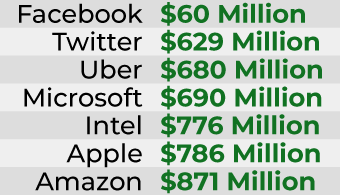
Environmental, social and corporate governance (ESG) is a new trend in investing. And it’s not just because younger generations care about providing a cleaner, more representative future. It’s actually just good business. And some of the biggest investment firms in the nation are leading the way.
Blackrock (NYSE:BLK) — the company that’s helping the Federal Reserve manage its multi-trillion dollar economic bail out — is one of ESG’s leading proponents.
Huge hedge funds and pension funds are also demanding more ESG-focused investment, and divestment from companies that aren’t ESG-friendly.
This kind of transition is great for the sectors that are rotated into. And one of those sectors is clean energy.
These 7 energy stocks to watch are some of the current beneficiaries of that shift:
- Clearway Energy (NASDAQ:CWEN.A)
- Vivint Solar (NASDAQ:VSLR)
- Brookfield Renewable Partners (NYSE:BEP)
- NextEra Energy (NYSE:NEE)
- Cosan Ltd (NYSE:CZZ)
- Atlantica Sustainable Infrastructure (NYSE:AY)
- Xcel Energy (NYSE:XEL)
According to the Portfolio Grader tool I use to find Growth Investor plays, all of these stocks are a “Buy” now.
Clearway Energy (CWEN.A)

Source: Pavel Kapysh / Shutterstock.com
Operating 1.2 GW of solar and 2.8 GW of wind in 25 states, Clearway is a leading renewable energy producer across the U.S. market.
That means it can sell energy to utilities, governments and other companies to help offset carbon emissions. This has become a big business, and smaller operations are getting acquired as larger operations consolidate the space.
This is a relatively new sector, so there’s long-term growth opportunity here. And having seen how other unregulated power companies operate, these new firms have a better idea how to navigate the energy markets.
This is all paying off for the company now. CWEN.A is up 26% in the past year and it still delivers an impressive 3.9% dividend.
Vivint Solar (VSLR)

Source: QualityHD / Shutterstock.com
Started 9 years ago in Utah, VSLR focuses on residential solar. It operates in 23 states covering the West, Southwest, South, Mid-Atlantic and New England.
Each state has local residential solar companies that set up various financial arrangements with homeowners where they can lease, finance, or outright buy the system. Alternatively, customers can simply pay VSLR a monthly fee for how much electricity they use.
By creating a variety of financing options, it makes it easier for a wide range of customers to buy into solar energy.
Solar has been a big winner of late in my newsletters such as Growth Investor. And that trend is only rising. ESG investing alone is a bullish catalyst, as it means more dollars are headed to companies exploring these new possibilities. Just remember that in a financial downturn, some of these types of financing may see rising defaults, which could rock the boat for Vivint.
VSLR is up 22% in the past year and a whopping 148% in the past 3 months.
Brookfield Renewable Partners (BEP)

Source: Diyana Dimitrova / Shutterstock.com
If you’re looking for a way to play the global shift to renewables, this Canada-based company is the way to go.
BEP has operations in the Americas, Europe and Asia, with a variety of renewable energy projects including solar, wind, distributed generation and energy storage.
Plus it’s set up as a limited partnership, which means investors are considered direct owners who get their net income paid to them as dividends. Right now, the stock yields a nice 4.5%.
Its global reach also means it covers markets where renewable energy isn’t just a nice option, but an important and key power source. Many developing nations are held hostage by the weather because of their reliance on hydroelectric dams. When the water isn’t flowing, the power supply disappears. New technologies add resiliency to these older modes of energy independence.
BEP is up 33% in the past 12 months with a solid $15 billion market cap, so investors should have no qualms about buying in.
NextEra Energy (NEE)

Source: madamF / Shutterstock.com
This is one of my favorite High-Growth Investments at Growth Investor, and probably one of the sexiest utilities in the market right now.
Basically, utilities have two parts, regulated and unregulated businesses. The regulated business is what we know of as an electric utility. It has a quasi-monopoly to generate power for a market, but its growth and profits are regulated by the state and federal governments.
The unregulated side can engage in energy generation and energy trading on the open market, buying and selling energy to industry, governments and utilities.
It’s the latter business that’s seeing huge growth from the renewables sector. Many traditional utilities don’t want to spend to develop renewable power, so they buy it from someone like NEE.
And that’s good business: NEE has become the largest producer of wind and solar energy in the world. That’s on top of its rock-solid regulated utility business Florida Power and Electric, which powers south Florida.
This ‘boring’ utility delivers a reliable 4.3% dividend, and is up 28% over the past year.
Cosan Ltd (CZZ)

Source: rafapress / Shutterstock.com
This Brazilian integrated energy firm is the fourth largest company in the Brazilian market.
It has its hands in all aspects of the energy markets, including renewables, oil and gas pipelines, natural gas utilities and agricultural commodities.
CZZ is one of South America’s leading suppliers of ethanol. But its ethanol doesn’t come from corn, as in the U.S., but sugar, which is widely available in Brazil and other Latin American countries.
Cosan also has significant natural gas operations, from exploration and production to pipelines to refining, distribution and storage.
With a market cap of $3.5 billion, it’s not a huge firm, but its diversity of energy products makes it an interesting choice for playing the energy market in South America.
CZZ has a 0.7% dividend, and the stock is up 20% in the past year. Given the COVID-19 troubles in Brazil, this is a good time to wade in.
Atlantica Sustainable Infrastructure (AY)

Source: Kodda / Shutterstock.com
European investors love dividends. Part of this is because they tend to have a significant amount of monies in pension funds, so they would prefer to make steady reliable gains than take big chances.
Plus, the last time that happened was the 2008 market collapse which left a lot of those managed funds hurting severely.
AY is a U.K.-based sustainable infrastructure company that owns a variety of assets in the Americas, Europe and Africa. It’s not completely renewable energy focused, but it does focus on clean energy projects and distribution.
With a $3 billion market cap, it isn’t a huge firm, but it’s likely well represented in most European institutional portfolios. And it’s catching on in the U.S. as well.
AY delivers a very generous 5.4% dividend, even after a 30% run in the past 12 months. And I’ve got more buys where that came from.
Xcel Energy (XEL)

Source: Shutterstock
This Minnesota-based utility serves the upper Midwest — Minnesota, Michigan, Wisconsin, the Dakotas — as well as Texas, Colorado and New Mexico. It also has a regulated gas utility that serves many of these states.
But it’s also one of first utilities to pledge to eliminate carbon-based fuels for its power generation. By 2022 it’s committed to 75% of its energy coming from clean energy sources. It plans to reduce its carbon emissions 80% by 2030. And it plans to be generating 100% carbon-free electricity by 2050.
These commitments have helped boost its profile in recent years and the stock is reaping the benefits.
XEL is up 6% in the past 12 months and has a 2.7% dividend.
If you’d like more growth and income in your portfolio – and who doesn’t? – then you’ve also got to look at lucrative megatrends like 5G. That does NOT, however, mean that you should focus on the Big Telecom stocks.
For my money, I’m not going to bet on any one application of 5G. Or even one provider of 5G. When I choose 5G stocks, I want the companies who make all of it possible.
The King of 5G “Turbo Button” Technology
Mobile providers like AT&T (NYSE:T) and Verizon (NYSE:VZ) need 5G to maintain their edge – and get people into new smartphone contracts. But the big profits will come from the companies that help create 5G.
One such company I like now is much lesser known than the Big Telecom companies but has excellent growth prospects.
This company is already one of the biggest semiconductor equipment manufacturers in the world. These days, its products for machine learning, optics, sensors and analytics are getting deployed for all sorts of next-generation technologies: the self-driving cars, robotics, cloud computing and the larger Internet of Things (IoT).
Most importantly for a Growth Investor, this stock is a “Strong Buy” in my Portfolio Grader now.
So, if that company doesn’t sound familiar to you, I’d like to change that. This is a specific subset of 5G stocks that can help you profit from all the 5G infrastructure that’s popping up everywhere.
I have a complete, freshly-updated investment report on it, called The King of 5G “Turbo Button” Technology. You can secure a copy by watching my free briefing on 5G stocks and joining us at Growth Investor today.
Editor's Note:
Bonus Pick: Google just poured $4 billion into THIS…
The world’s most successful tech industry giants are all clamoring to get their hands on a new piece of technology.
It’s fresh out of a highly secretive lab in Boston, Massachusetts, and it’s poised to make early investors billions.
It’s NOT cannabis. It’s NOT bitcoin, or some other blockchain-related technology. It’s NOT 5G.
And as a matter of fact, it could be bigger than all of those. Because if history is any indicator, you could be looking down the barrel of 5,000% profits… or even more.
Companies all over the world are funneling as much money as they can into what Bill Gates calls, “the holy grail” of modern technology.
Take a look at some of the top contenders and their spending history:
But Google takes the cake by a landslide. They’ve poured more than $3.9 BILLION into this mind-blowing new tech that’s taking the world by storm.
Click here to see this brand new tech in action, and find out how it could make you 10… 20… even 50 times your money.









